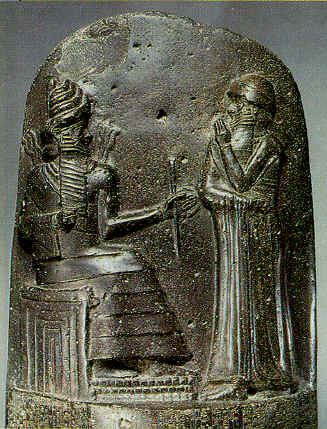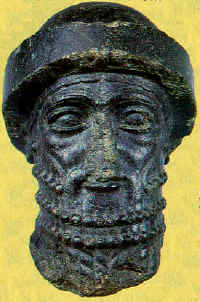The Torah: Did Moses Steal the Ten Commandments?
Shushan, which lies 200 miles east of Babylon, was the capital of ancient Elam (Susiana), and later the winter palace of the Persian kings. It was the scene of many biblical events in the time of Daniel, Nehemiah, Queen Esther and King Ahasuerus (Xerxes).
 |
| The upper portion of the famous Law Code Stele of Hammurabi (above) shows Hammurabi standing before the sun-god Shamash, the god of justice. Many scholars believe the diorite head (below), discovered at Susa, represents Hammurabi. |
 |
French archaeologists began excavations at Shushan in 1852. M. Dieulafoy discovered the palace fortress that the writer of the book of Esther calls the citadel of Susa. In 1901, another expedition, led by de Morgan, uncovered three fragments of black stone. After being fitted together, they formed an impressive round-top stele or pillar, which stands about 7.5 feet high. This was a copy of the Law Code of King Hammurabi, considered one of the most significant legal documents from antiquity. (Hammurabi was the sixth king of the first dynasty of Babylon, whose dating is controversial but commonly given as 1792-1750 B.C.) The stele is now displayed at the Louvre in Paris, France.
A relief on the upper face of the stele depicts the king in worship before the sun god on a throne. The code begins with a prologue, followed by 300 laws. These can be divided into 12 sections of law: legal process, thieves, vassals, homes and land, trade, inns, deposits, family, injury to others, building, hiring, and the treatment of slaves. Sixty-seven paragraphs cover the major subjects of marriage, family and property.
This discovery was particularly important to Bible scholars. First, it supported the authenticity of the law of Moses. Some Bible critics had held that the art of writing and the science of law were unknown in that early period of history. But here was specific evidence that both were well known.
Second, there were striking parallels between some of Hammurabi’s statutes and those of Moses in the Book of the Covenant. For example, in citing the law for personal injury, Hammurabi’s statute 206 states: “If a man wound another accidentally in a quarrel with a stone or his fist, and oblige him to take his bed, he shall pay for the loss of his time and for the doctors.” The law of Moses, for the same offense, is remarkably similar (Exodus 21:18-19).
The similarity between these and a few other statutes left the way open for some critical scholars to postulate that the Mosaic law in the Bible was derived from the Code of Hammurabi. Most scholars, however, have abandoned this theory, since further research has shown that, in ancient times, there were codes of law in various countries. Some of these were even older than Hammurabi’s stele.
Furthermore, Mosaic law moved beyond the Code of Hammurabi, or any of the ancient law codes, because it is grounded in the worship of one God. The ethical principles in the law of Moses spring from love toward the one true God. Such love demands that one also love fellow human beings, whom God made in his image. Moses thus talks about human sin and our responsibility to God in resisting sin. Hammurabi and other ancient lawgivers, however, do not address this issue.
Hammurabi’s law code is civil and criminal. Moses’ law code, on the other hand, begins with spiritual principles — love toward God and humans — from which the civil and criminal laws are derived. From its stress on the motive of love, the law of Moses demanded more humane treatment for slaves, gave higher regard for womanhood, and placed greater value upon human life in general. The priority given to such spiritual values made the Mosaic law unique among all the ancient law codes.

